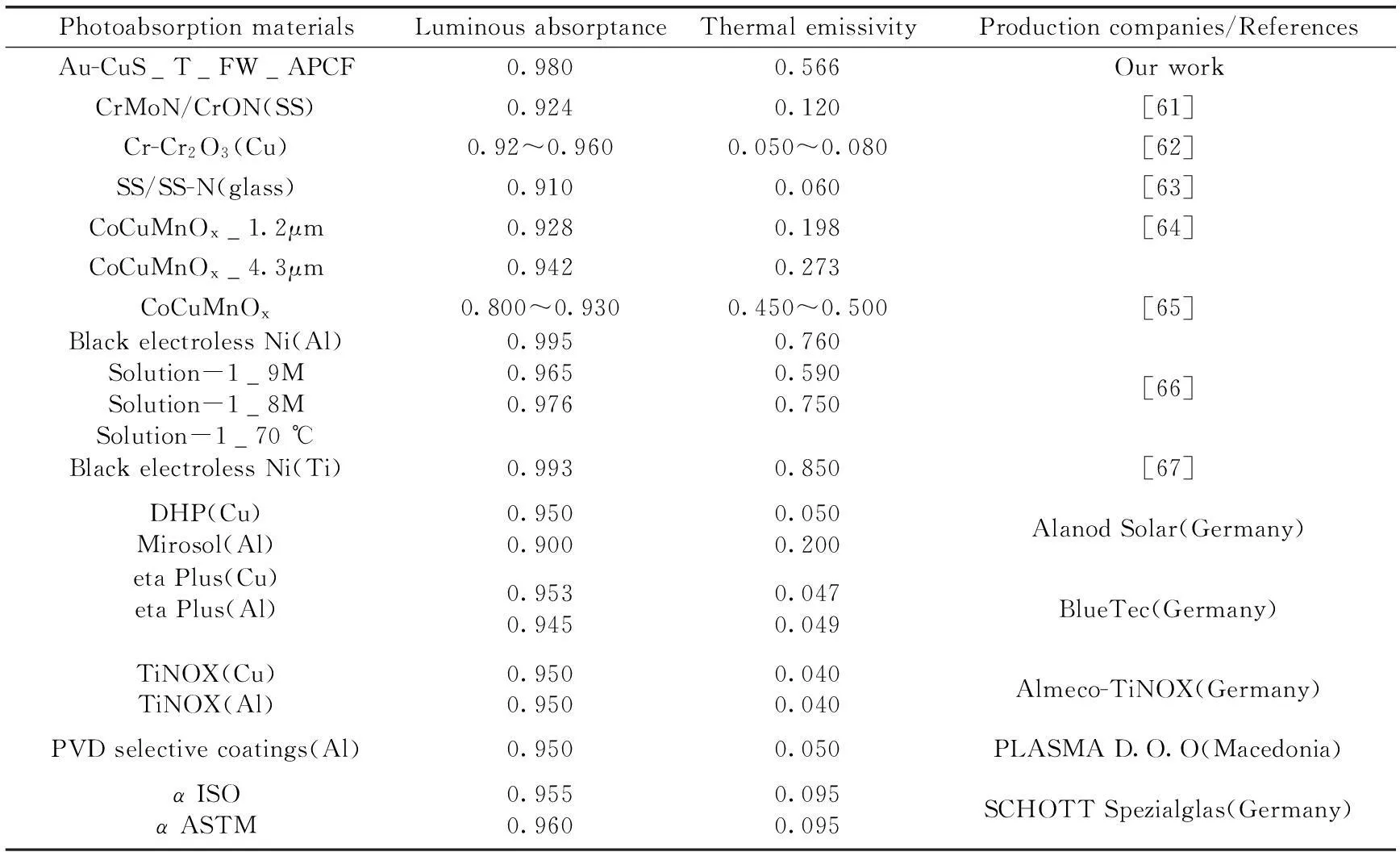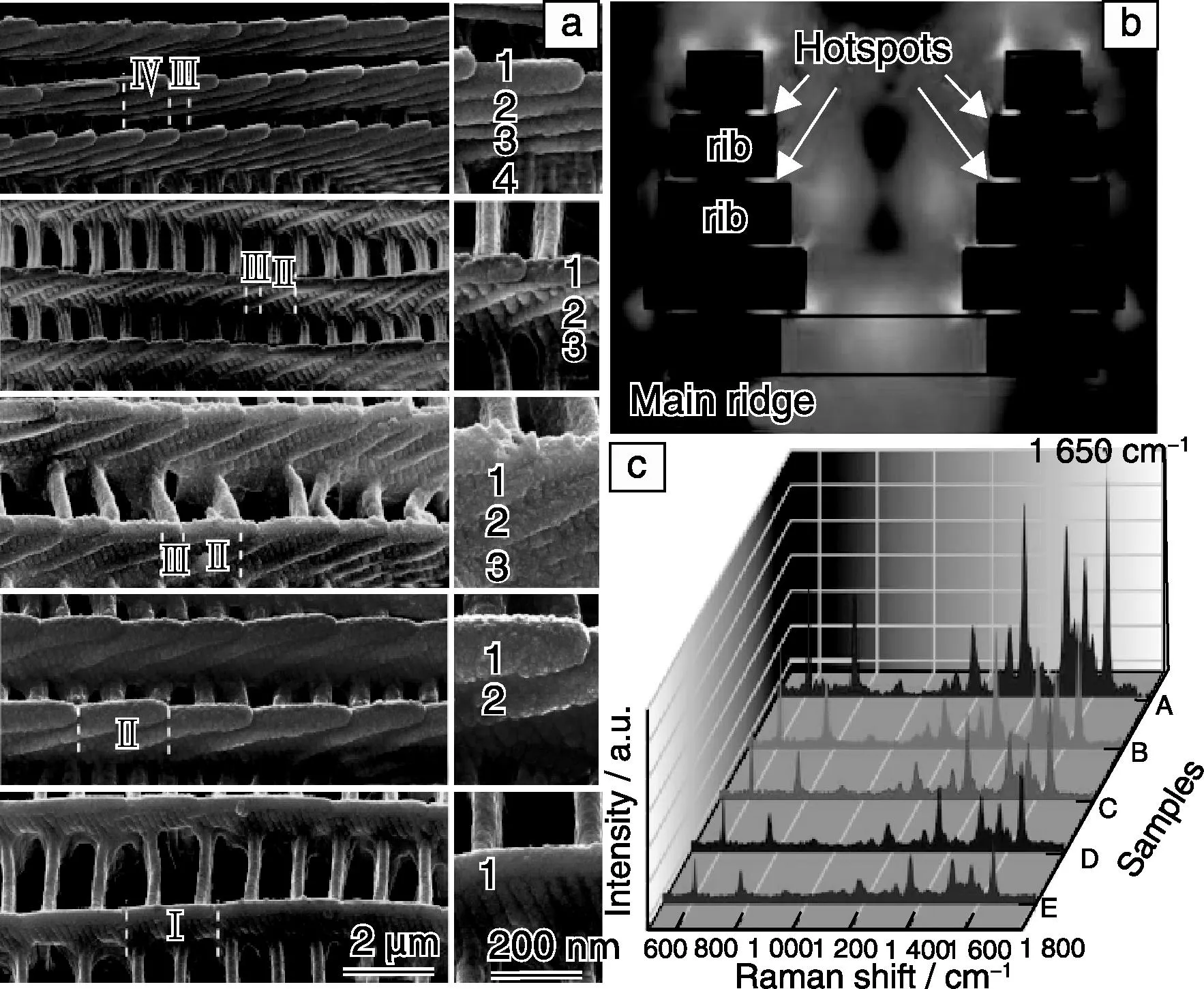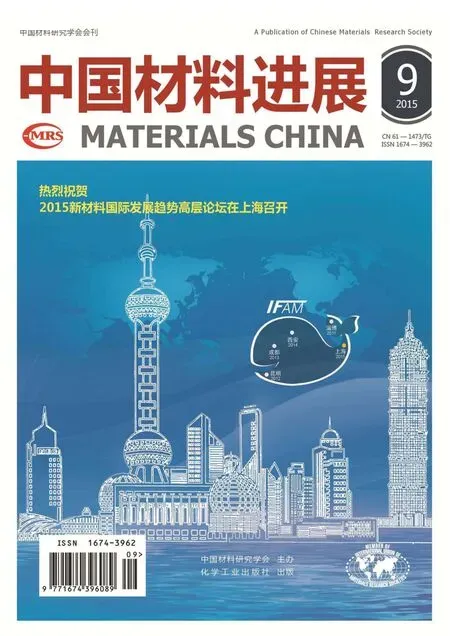启迪于蝶翅分级精细结构的遗态功能材料
2015-02-25顾佳俊苏慧兰
张 旺,顾佳俊,苏慧兰,张 荻
(上海交通大学 金属基复合材料国家重点实验室,上海 200240)

第一作者:张旺,男,1981年生,副研究员
zhangdi@sjtu.edu.cn.
启迪于蝶翅分级精细结构的遗态功能材料
张旺,顾佳俊,苏慧兰,张荻
(上海交通大学 金属基复合材料国家重点实验室,上海 200240)
摘要:传统设计与制备技术手段往往难以实现预期精细结构与功能构筑,从而限制了材料结构-性能之间新现象的发现与新机理的建立。借用经亿万年自然优化的生物自身多层次、多维和多尺度的本征结构为模板,通过物理和化学手段,在保留生物精细分级结构的同时,置换生物模板的化学组分为所需功能组分,利用生物精细结构与人工组分之间的耦合关系,可制备既遗传自然生物精细形态,又有人为赋予特性的新材料——遗态材料。围绕具有蝶翅精细结构的遗态光功能材料,分别以金属-半导体功能蝶翅的红外吸收增强及光热转换、金属功能蝶翅的表面等离子体拉曼增强为例,介绍了遗态材料的设计思路、制备方法、性能表征及相关机理探索过程。相关思路与方法为解决分级精细结构难以制备的难题提供了新途径,并为新材料构型设计提供了前瞻性思路和原理验证。
关键词:遗态材料;分级结构;光功能材料;仿生材料
1前言
材料是人类赖以生存及发展的基础,其发展水平为衡量人类社会文明程度的标志之一。随着科技的进步、工业水平的提高以及社会的发展,材料的应用领域不断扩展、应用环境不断更新,对材料的功能与性能要求也日益提高,其中先进功能材料已经成为通讯、电子、能源、交通、生物和医疗等领域发展的基础。目前,仅限于材料本征特性的功能材料已不足以满足人类社会发展的需要。伴随着现代科学技术及交叉学科的发展,为实现材料的多维度、多组分、多功能及高性能的有效结合和统一,结构功能一体化新型功能材料应运而生。材料与分级功能结构耦合不仅可优化功能材料的性能,而且可以拓展材料的功能,从而从广度和深度上促进功能材料的发展。因此开发和研究结构功能一体化新型功能材料具有重要的学术价值和现实意义。
在过去的数十年里,结构和功能一体化新型功能材料得到了长足的发展,如三维铜光子晶体[1]、超薄等离子体超吸收材料[2]、具有渔网结构的负折射率材料[3]、超宽波段微波吸收材料[4]、宽波段减反射硅纳米材料[5]、具有加强磁性能的磁性纳米孔阵列[6]、单壁碳纳米管整列黑体吸收材料[7]及具有加强光吸收及载流子收集性能的硅线阵列[8]等。然而,受技术条件限制,目前很难在亚微米尺度上制备具出有复杂精细分级功能结构的结构功能一体化新型功能材料。反观自然界生物体经亿万年的自然选择、进化,为生存与繁衍进化出了一系列具有相应功能的多尺度(从宏观尺度到纳米尺度)功能结构,其复杂及精细程度远超人工加工水平。这些经自然选择所得的设计方案为制备具有分级精细功能结构的结构功能一体化新型功能材料提供了灵感。“师法自然”, 以自然界精细分级功能结构为模板,将其复制为特定功能材料,将生物功能结构与材料本征特性相结合,从而创制出一系列功能强大且通过其他方法难以获取的新型功能材料(遗态材料)[16],为开发高性能材料,发现相关新现象、新机理从而指导材料的人工设计提供了一条有效捷径[9-15]。
典型生物中,鳞翅目昆虫(蝴蝶和飞蛾)为一巨大属群,有近180 000种[17]。其主要特征为翅膜上普遍覆盖着数以万计的鳞片。为适应生存环境和配偶繁殖的需要,这些鳞片经长期进化具有了不同的纳米-亚微米尺度的分级结构,呈现各种色彩[17]。此类分级精细结构已被广泛用于设计遗态材料,在气敏器件[18-19]、结构色控制[20]、太阳能电池[21]、光学防伪[22]、高速红外成像[23]、光解水制氢[24]、拉曼增强[25-26]、pH值响应[27]、磁光响应[28]和光吸收[29]等领域展现出优异的性能。
本文针对黑色吸光蝶翅的光吸收、金属-半导体功能蝶翅的红外吸收增强及光热转换性能、金属功能蝶翅的表面等离子体拉曼增强等分别进行概述。这些微纳结构与材料本征特性的成功耦合为材料性能的突破、功能的拓展提供了独特的实现途径,为相关构效关系的研究提供了大量材料原型,并为新材料的设计提供了前瞻性思路与借鉴。
2黑色蝶翅的光吸收性能
微纳减反射吸光结构在凤蝶的黑色鳞片中广泛存在,呈现为一种微纳孔阵结构。由菲涅尔定律可知,在材料和环境的光滑界面处当两者折射率差异较大时,可产生较高的反射率[30]。如在一光滑硅片表面,垂直入射光的反射率可达34%,但是一旦将其表面改为亚波长孔结构,其反射率可锐减至1%[31]。
通过对凤蝶蝶翅的微纳孔阵结构研究发现,光吸收率可随孔径增大、孔壁变薄和孔深变浅而下降。通过对孔壁厚度D、孔深度H和孔大小L进行仿真模拟发现,不同的D、H和L值组成结构的吸收率差别很大。D、H和L值决定了结构所消耗材料的多少。因此可以找到以较少材料实现较大吸收的D、H和L值。研究结果显示,相对于简单膜结构,微纳孔阵结构在600 nm单波长可以节省84%的材料,而在可见光波段可以节省59%的材料,如图1所示。

图1 不同波长下孔阵结构和薄膜结构的吸收率对比:(a) 波长为600 nm; (b) 为结构模型;(c) 波长为400~800 nm。Fig.1 Optimization of the micro/nano-hole structure: (a) the optimized results under wavelength 600 nm by contrast with thin film structure, (b) the models of micro/nano-hole structure and thin film structure,and (c) the optimized results under broad wavelength range from 400~800 nm by contrast with thin film structure
此外微纳孔阵结构的孔形状主要影响材料对不同角度入射光的吸收性能。人工制备的规则四方结构、六方结构和圆孔结构的吸收谱会呈现与其对称结构对应的角度取向,从而会使得吸收谱中存在一些光吸收盲点,不利于光的充分吸收。而凤蝶的微纳孔阵结构呈现为长程有序、短程无序的特点,可以很好规避吸收盲点,使其能吸收各个方向的入射光,从而实现全向光吸收性能。其结构图如图2所示,吸收谱如图3所示。

图2 结构模型和边界条件: (a)基于Papilio ulysses蝶翅结构的带脊结构的不规则孔阵结构M0:a-1:球坐标系,位相角和仰角的示意图,a-2:M0的一个周期,a-3:Papilio ulysses的锥形脊结构;(b) 3个对称结构M1,M2和M3的模型,它们的占空比和孔面积保持与M0相同,分别为0.27和0.176 μm2;(c)在水平方向(x和y方向)为周期性边界条件(PBC),而在竖直方向(z方向)为吸收性边界条件(PML), 光源设置为平面波光源Fig.2 Structure model and boundary conditions: (a) M0: the dissymmetric model with ridges derived from the Papilio ulysses, a-1: the sketch map of polar angle θ, azimuth angle φ and coordinate system, a-2: one period of the M0, a-3: the tapered ridges of Papilio ulysses; (b) three symmetric model of M1, M2 and M3, the filling ratio and the hole’s area are fixed at 0.27 and 0.176 μm2;and (c) periodic boundary conditions (PBC) and absorbing boundary conditions by perfectly matched layer (PML) are applied in horizontal (x & y) directions and vertical (z) directions, respectively
微纳孔阵结构加强光吸收的内在原因可归结如下:①由于孔的存在,其等效折射率可以看成是空气的折射率和硅的折射率的结合,等效折射率小于完整的纳米硅片结构,而折射率决定了反射率的大小[32],所以纳米孔结构的反射率小于硅片结构,即纳米孔结构的光吸收大于硅片结构。②硅片在长波长区域的折射率虚部较小,导致此部分的透射率比较大。而在微纳孔阵结构中,由于等效折射率常数减小,故透射率比硅片要大。但是因为微纳孔阵结构的尺寸效应,它在短波长和硅片中有着差不多的透射率。当微纳孔阵结构的尺寸比入射光波长要小时,几何光学理论将不再适应,孔阵结构将会同时吸收孔阵表面的光和附近的光,这会降低体积平均导致的折射率减弱效应,从而增加光吸收[33]。③由于电磁波谐振作用,微纳孔阵结构周期性的边长会具有较好的光吸收。以上特征为利用凤蝶蝶翅结构制备光吸收遗态功能材料创造了条件。
3金属-半导体蝶翅遗态材料的光热转换
近年来通过大量的研究,科学家们制备了具有高吸收和高红外光热转换性能的红外光热材料,如当被800 nm红外光辐照后表现出优异的红外光热转换性能的银纳米壳(13%)、金纳米杆(21%)和硒化铜(Cu2-xSe)纳米材料(22%)[43],当被980 nm红外光辐照后表现出优异的红外光热转换性能的亲水性Cu9S5纳米晶(25.7%)及金纳米杆(23.7%)[44]。然而,以上这些光热转换材料仅仅由单一成分组成,从而限制了其多功能性能应用。目前,大量多成分纳米复合材料被合成(如:金属/金属[45-46]、金属/半导体[47-52]及半导体/半导体复合成分[53-54]),并被广泛应用于光学、生物医学、催化作用、太阳能转换、电子学、磁学[55-56]及光热转换[51-52]。

图3 模型M0~M3在600 nm波长的极化等值线吸收谱。同时给出了偏振s、p和非偏振态以及对应的平均值、标准差、极小值和极大值Fig.3 Polar contour plots of absorption with model M0 to M3 at a wavelength of 600 nm. The polarized s, p and unpolarized light, and average, standard deviation, minimum, maximum were applied, respectively
为了增强宽波段的太阳光谱吸收及提高红外光热转换性能,功能材料需要具有高光吸收和低反射光学功能结构。自组装这些多成分复合纳米颗粒成为薄膜或块体材料,特别是具有相应功能的亚微米功能结构的薄膜或块体材料,可进一步扩展多成分复合材料的多功能性应用[56]。然而,由于受当今传统制备工艺的限制,如自发外延形核、形核点生长技术等,很难制备出由多成分复合纳米颗粒组成的,且具有亚微米功能结构的宏观厘米级多功能薄膜材料[45-56]。
为了突破传统制备工艺的的限制,可采用仿生遗态模板法,以裳凤蝶前翅鳞片(T_FW)为模板,在宏观厘米尺度下制备具有光吸收特性的金属/半导体复合功能蝶翅(Au-CuS_T_FW)。所制备的Au-CuS_T_FW具有加强的宽波段光谱吸收性能,特别在红色光及红外光波段其加强宽波段光吸收性能更为明显;并且具有优异的红外光热转换性能,如图4-5所示。

图4 裳凤蝶的光学照片(a); 裳凤蝶前翅(T_FW)的扫描电镜照片(b);Au-CuS_T_FW的扫描电镜照片(c)Fig.4 Optical image of Troides Helena (a), SEM image of the T_FW (b) , and cross-section SEM image of T_FW (c)

图5 Au-CuS_T_FW及相应对比材料在300~2 500 nm (a)和2.5~15 μm (b)光波长范围内的光吸收图谱;光功率为0.439 W/cm2 980 nm近红外光照射时,Au-CuS_T_FW及相应对比材料分别通过光热转换加热测温系统测量的温度变化图 (c);Au-CuS_T_FW的热传递时间常数的分析图 (d)Fig.5 The absorption spectra of the Au-CuS_T_FW and other contrast samples over the wavelength range of 300~2 500 nm (a) and 2.5~15 μm (b), the temperature elevation of the system included the water, the beaker bottom and the photothermal conversion material (Au-CuS_T_FW, CuS_T_FW, Au_T_FW, T_FW and BlueTec eta plus_Cu) during a continuous irradiation period by a 0.439 W/cm2 NIR laser at 980 nm(c), the time constant for heat transfer from the system (Au-CuS_T_FW) was determined to be τs=195 s by applying the linear time data from the heating period (20 min) versus negative natural logarithm of 1 subtracted driving force temperature(d)
经分析可知,Au-CuS_T_FW优异的宽波段光吸收性能,特别是在红色光区域和红外光区域的光吸收加强机制首先源于Au纳米颗粒和CuS纳米颗粒的等离子体-激子/等离子体耦合效应。该效应可促进入射电磁场在纳米材料表面聚集、增强,促进光吸收。其次,近邻等离子体相互作用加强宽波段红外吸收。再次,等离子体-激子/等离子体耦合效应和近邻等离子体相互作用与T_FW的AQPS耦合,实现功能结构与功能材料一体化,进一步加强宽波段光吸收[57-60]。同时Au-CuS_T_FW中的Au纳米颗粒的等离子体扰动加强光吸收,使入射光场聚集、增强,从而增强扰动促使CuS纳米颗粒的激子跃迁和CuS纳米颗粒载荷子的等离子体振荡,加强振荡促进光热转换;并且近邻等离子体共振相互作用可进一步加强等离子扰动促进光热转换;等离子体-激子/等离子体与T_FW的AQPS结构耦合,使入射光场在沉积有Au-CuS纳米材料的AQPS表面,特别是在AQPS中三角屋顶状脊结构表面,汇集、放大,加强纳米晶载荷子振荡,加速振荡载荷子的动能转换为热能,从而进一步促进光热转换。
将Au-CuS_T_FW粘贴在与BlueTec eta plus_Cu一样的铜基板上所得的Au-CuS_T_FW太阳能吸收膜(Au-CuS_T_FW_APCF),其太阳能吸收比高达98%,高于大多数优异的商用太阳能集热器的光吸收膜及实验室制备的光吸收膜。于此同时,Au-CuS_T_FW_APCF的热发射比仅为0.566。与表1中目前商用化太阳能吸收膜和实验室制备的太阳能吸收膜相比(91.0%-97.6%),对于热发射比小于0.600的参照物,Au-CuS_T_FW_APCF具有最高的太阳光吸收比(98%),而且还具有优异的太阳能光热转换性能,并能有效地应用于低温(T<60 ℃)太阳能光热集热器。

表1 太阳能集热器光吸收膜的吸收比和发射比
进而可通过模拟Au-CuS_T_FW的红外光吸收及光热转换特性。图6说明了等离子体振荡、近邻等离子体相互作用与AQPS耦合促进入射电磁场聚集、扩大等离子体材料附近电场强度。由图6f所示,热源产生于光热转换材料(Au纳米颗粒和CuS纳米颗粒)。并且在两个近邻等离子体区域,其热源密度更强,从而说明了近邻等离子体振荡系统的耦合效应增强热能产生。由图6i所示,Au-CuS_T_FW的热源来自于覆盖有光热材料的(Au纳米颗粒和CuS纳米颗粒)的AQPS结构表面。并且结合图6d和6h所示,进一步佐证了T_FW的AQPS通过准周期性排列的三角屋顶状脊结构多次减反射,聚集增强入射光场在AQPS内部分布;通过微纳孔状窗口结构延伸、扩展入射光场的分布空间,从而加强入射光场与吸光、光热材料的相互作用。其强电磁场进一步有利于加强等离子体材料的振荡,因此促进并加强光吸收、光热转换,使AQPS表面具有明显的强电磁场能流密度分布和强热源密度分布。
该工作充分利用了自然界的精细光吸收结构,实现了金属等离子与半导体耦合,为制备具有亚微米精细光吸收功能结构的金属/半导体复合材料提供了有力支持,并对促进、扩展红外应用具有重要意义。Au-CuS_T_FW材料有望应用于太阳能光吸收、光热转换薄膜,特别是针对红外光波段的光吸收及光热转换薄膜。

图6 当入射光波长为980 nm时,(a)、(b)、 (c)和(d)分别为Au-CuS NPs、Au-CuS NPs_Chitin、T_FW和Au-CuS_T_FW的电磁场能流密度分布图;(e)和(h)分别为Au-CuS NPs_Chitin和 Au-CuS_T_FW的分布图;(f)和(i) 分别为Au-CuS NPs_Chitin和Au-CuS_T_FW的热源密度分布图;(g)和(j) 分别为Au-CuS NPs_Chitin和Au-CuS_T_FW的温度分布图,(i)中的插图为相应白框区域内图像的放大图Fig.6 Maps of the electromagnetic field energy flux density amplitude of Au-CuS_NPs(a), Au-CuS_NPs_Chitin(b), T_FW (c) and Au-CuS_T_FW(d), intensity distribution maps of Au-CuS_NPs_Chitin (e) and Au-CuS_T_FW (h), and heat source density maps of Au-CuS_NPs_Chitin (f) and Au-CuS_T_FW (i), temperature maps of Au-CuS_NPs_Chitin (g) and Au-CuS_T_FW (j), the insets of (i) are the heat source density distributions in the white rectangular regions at a higher magnification. The wavelength of the incident light is fixed under 980 nm
4金属蝶翅遗态材料表面增强拉曼散射
金属等离子体材料因其可以通过高效率的表面等离子体共振响应(SPR)以调控光的传输而获得广泛的研究和关注,其等离子体特性不仅由金属本征特性,更由其亚波长维度的微纳结构决定,因此具有精细新颖的微纳结构的金属等离子材料的设计和制备成为近年的研究热点。鉴于人工制备方法的低效率与高费用,自然界提供的各种具有精细分级多层维纳结构的生物模板为我们提供了新的思路。

图7 金属蝶翅鳞片:(a)和(b)为E. mulciber;(c)蝶翅鳞片的光镜照片;(d)7种金属蝶翅鳞片遗态材料[34-35]Fig.7 Metallic wing-scale replicas:(a) and (b) E.mulciber, (c)optical microscopy image of scales, (d) seven metallic replicas. Reproduced with permission. [34-35] Copyright 2011 and 2012, John Wiley and Sons
例如以异型紫斑蝶蝶翅紫色区域具有三维树枝状结构的鳞片作为模板,可通过蝶翅模板表面功能化、金属离子化学沉积、模板去除等步骤制备出7种具有原始生物模板三维精细结构的金属等离子体材料(图7)。在制备过程中,蝶翅先经乙二胺活化,可获得更多的铵基基团,有利于吸附更多AuCl4离子,为蝶翅的活化处理和化学镀过程奠定了基础。进而采用NaBH4溶液还原吸附在蝶翅表面的AuCl4离子,可在蝶翅鳞片表面形成一层大小均一的金纳米颗粒,为进一步形成各种金属纳米层提供催化核心。经化学金属沉积后,在室温下利用H3PO4去除生物模板,相比传统的高温烧结方法,低温溶解法更精准地保留原始蝶翅的微纳结构,从而获得具有蝶翅精细分级结构的金属材料。所得材料在亚微米水平上完好保留了原始蝶翅的三维有序精细微纳结构(图8)[34-35],为高效构筑结构复杂、性能强大的金属微纳器件提供了设计新思路和创制新方法。

图8 原始蝶翅鳞片和7种金属蝶翅鳞片的形貌对比[34-35]Fig.8 FESEM images of an original butterfly wing scale and seven metallic replicas (Co, Ni, Cu, Pd, Ag, Pt, and Au). Reproduced with permission. [34-35] Copyright 2011 and 2012, John Wiley and Sons
作为典型演示范例,以Au蝶翅作为SERS基片来研究其拉曼增强特性,发现在基于SERS现象的痕量物质识别方面,Au蝶翅与国际流行的商用SERS基板Klarite®(Au)相比可将罗丹明6G分子的检出灵敏度提高整整一个数量级(10-13M),在检出信号重复性相当的同时价格仅为Klarite的1/10,展现出优异的拉曼信号增强性能及广泛的实际应用前景[34-35]。为阐明相关机理并在多达17万种的蝴蝶与蛾类中寻找最佳的生物模板构型,依据蝶翅鳞片的三维精细构造建模,并利用基于麦克斯韦方程组的有限元方法对其在光激发条件下内部的电磁场局域模式进行了研究解析。结果表明金属蝶翅内部尺度为20~30 nm的肋状层结构[34-35],在光场激发下,可将电磁场局域增强区沿第三维方向拓展,从而提升金属蝶翅的SERS性能,且拉曼增强效果随着蝶翅的肋状层数目的增加而提高(图9)。该发现同时也为今后人工制备具有超越自然蝶翅肋状层数,从而具备超高性能的SERS基片提供了理论设计依据。随后这一理论被人工制备的具有多层结构的纳米柱阵列证实[36]。
除了蝶翅的树枝状结构,生物界还提供了许多其他的具有精细纳米结构的生物模板,例如具有纳米针阵列的蝉翅减反射结构、玫瑰花瓣等都被成功地用作生物模板制备金属等离子体材料,并用于物理、化学、生物领域分子的SERS检测[37-40]。这些精细的维纳结构不仅可以直接作为模板制备金属等离子材料,还可以为人工设计和制备金属等离子体材料提供新的思路,另外研究者们已经开始尝试通过纳米压印等方法准确的复制生物模板的结构[41-42]。通过选择合适的模板,合理的控制金属的体积分数,以及适当的结构修饰,可获得具有更高SPR效率和更多功能的金属等离子体材料。

图9 具有不同脊数目的Cu蝶翅扫描电镜照片(a),树枝状结构的理论电磁场分布(b);(b)中所对应Cu蝶翅对10-4 M浓度R6G的SERS检测信号(c) [34-35]Fig.9 SEM images of five different wing scales with different number of ribs(a), theoretical distribution of EM fields under excitation on metal scales of E.mulciber(b) , and SERS of R6G with a concentration of 10-4 M collected on the scales demonstrated in (b)(c). Reproduced with permission. [34-35] Copyright 2011 and 2012, John Wiley and Sons
5结语
遗态材料的思路与方法将天然生物结构直接与人工材料组分相结合,建立了将生物结构转化为具备光、电、磁、热、催化等多种氧化物、金属及其复合材料的技术原理及实现手段,揭示了一系列分级精细结构与组分的耦合机理,为构筑新型高性能结构-功能一体化材料提供了设计思路、理论依据和实用途径。由于本文篇幅所限,无法涵盖所有的相关研究。目前该思路已在大量材料体系中得到贯彻,在获得一系列高性能功能材料的同时,促进了新现象的发现与新机理的提出,并为新材料的设计、制备提供了理论依据与前瞻性的实现途径。未来研究一方面需通过学科交叉,围绕特定需求,寻找经自然优化、具有相应功能特性的生物结构;另一方面,需依据常见生物质的化学特性,开发具有共性特征的遗态材料制备流程,为此类材料的标准化与规模化应用奠定基础。
参考文献References
[1]Tal A, Chen Y S, Williams H E,etal. Fabrication and Characterization of Three-Dimensional Copper Metallodielectric Photonic Crystals[J].OpticsExpress, 2007, 15 (26): 18 283-18 293.
[2]Aydin K, Ferry V E, Briggs R M,etal. Broadband Polarization-Independent Resonant Light Absorption Using Ultrathin Plasmonic Super Absorbers[J].NatureCommunications, 2011, 2:193-198.
[3]Xiao S, Drachev V P, Kildishev A V,etal. Loss-Free and Active Optical Negative-Index Metamaterials[J].Nature, 2010, 466: 735-738.
[4]Ding F, Cui Y, Ge X,etal. Ultra-Broadband Microwave Metamaterial Absorber[J].AppliedPhysicsLetters, 2012,100: 103 506.
[5]Huang Y F, Chattopadhyay S, Jen Y J,etal. Improved Broadband and Quasi-omnidirectional Anti-reflection Properties with Biomimetic Silicon Nanostructures[J].NatureNanotechnology, 2007, 2: 770-774.
[6]Duong B, Khurshid H, Gangopadhyay P,etal. Enhanced Magnetism in Highly Ordered Magnetite Nanoparticle-Filled Nanohole Arrays[J].Small, 2014,10: 2 840-2 848.
[7]Mizuno K, Ishii J, Kishida H,etal. A Black Body Absorber from Vertically Aligned Single-Walled Carbon Nanotubes[J].ProceedingsoftheNationalAcademyofSciences, 2009,106: 6 044-6 047.
[8]Kelzenberg M D, Boettcher S W, Petykiewicz J A,etal. Enhanced Absorption and Carrier Collection in Si Wire Arrays for Photovoltaic Applications[J].NatureMaterials, 2010, 9: 239-244.
[9]Gu J, Zhang W, Su H,etal. Morphology Genetic Materials Templated from Natural Species[J].AdvancedMaterials, 2015,27: 464-478.
[10]Tao P, Shang W, Song C,etal. Bioinspired Engineering of Thermal Materials[J].AdvancedMaterials,2015,27: 428-463.
[11]Yu K, Fan T, Lou S,etal. Biomimetic Optical Materials: Integration of Nature’s Design for Manipulation of Light[J].ProgressinMaterialsScience, 2013, 58: 825-873.
[12]Liu K, Jiang L. Bio-inspired Design of Multiscale Structures for Function Integration[J].NanoToday, 2011, 6: 155-175.
[13]Zhang D, Zhang W, Gu J,etal. Inspiration from Butterfly and Moth Wing Scales: Characterization, Modeling, and Fabrication[J].ProgressinMaterialsScience, 2015, 68: 67-96.
[14]Wegst U G, Bai H, Saiz E,etal. Bioinspired Structural Materials[J].NatureMaterials, 2014,14(5866): 1 053-1 054.
[15]Bhushan B. Biomimetics: Lessons from Nature-An Overview, Philosophical Transactions of the Royal Society A: Mathematical[J].PhysicalandEngineeringSciences, 2009, 367: 1 445-1 486.
[16]Zhang Wang(张 旺). 蝶翅分级结构功能氧化物的制备与耦合性能的探索研究[D].Shanghai:ShanghaiJiaoTongUniversity(上海交通大学), 2008.
[17]Foottit R G, Adler P H. Insect Biodiversity: Science and Society[J].JohnWiley&Sons, 2009.
[18]Potyrailo R A, Ghiradella H, Vertiatchikh A,etal. Morpho Butterfly Wing Scales Demonstrate Highly Selective Vapour Response[J].NaturePhotonics, 2007,1: 123-128.
[19]Zhang W, Tian J, Wang Y,etal. Single Porous SnO2Microtubes Templated from Papilio Maacki Bristles: New Structure towards Superior Gas Sensing[J].JournalofMaterialsChemistryA, 2014, 2: 4 543-4 550.
[20]Huang J, Wang X, Wang Z L. Controlled Replication of Butterfly Wings for Achieving Tunable Photonic Properties[J].NanoLetters, 2006, 6: 2 325-2 331.
[21]Zhang W, Zhang D, Fan T,etal. Novel Photoanode Structure Templated from Butterfly Wing Scales[J],ChemistryofMaterials, 2008, 21: 33-40.
[22]Kolle M, Salgard Cunha P M, Scherer M R,etal. Mimicking the Colourful Wing Scale Structure of the Papilio Blumei Butterfly[J].NatureNanotechnology, 2010, 5 :511-515.
[23]Pris A D, Utturkar Y, Surman C,etal. Towards High-Speed Imaging of Infrared Photons with Bio-inspired Nanoarchitectures[J].NaturePhotonics, 2012, 6: 195-200.
[24]Chen J, Su H, Liu Y,etal. Efficient Photochemical Hydrogen Production under Visible-Light over Artificial Photosynthetic Systems[J].InternationalJournalofHydrogenEnergy, 2013,38: 8 639-8 647.
[25]Tan Y, Gu J, Zang X,etal. Versatile Fabrication of Intact Three-Dimensional Metallic Butterfly Wing Scales with Hierarchical Sub-micrometer Structures[J].AngewandteChemie, 2011, 123: 8 457-8 461.
[26]Tan Y, Gu J, Xu L,etal. High-Density Hotspots Engineered by Naturally Piled-Up Subwavelength Structures in Three-Dimensional Copper Butterfly Wing Scales for Surface-Enhanced Raman Scattering Detection[J].AdvancedFunctionalMaterials, 2012,22: 1 578-1 585.
[27]Yang Q, Zhu S, Peng W,etal. Bioinspired Fabrication of Hierarchically Structured, pH-Tunable Photonic Crystals with Unique Transition[J],ACSNano, 2013, 7: 4 911-4 918.
[28]Peng W, Zhu S, Wang W,etal. 3D Network Magnetophotonic Crystals Fabricated on Morpho Butterfly Wing Templates[J].AdvancedFunctionalMaterials, 2012,22: 2 072-2 080.
[29]Zhao Q, Fan T, Ding J,etal. Super Black and Ultrathin Amorphous Carbon Film Inspired by Anti-reflection Architecture in Butterfly Wing[J].Carbon, 2011, 49: 877-883.
[30]Jin R, Cao Y, Mirkin CA,etal. Photoinduced Conversion of Silver Nanospheres to Nanoprisms[J].Science, 2002, 294: 1 901-1 903.
[31]Yin Y, Alivisatos A P. Colloidal Nanocrystal Synthesis and the Organic-Inorganic Interface[J].Nature, 2005, 437: 664-670.
[32]Piller H, Palik E. Handbook of Optical Constants of Solids[J],PartII:Critiques.Subpart,1985, 2.
[33]Hu L, Chen G. Analysis of Optical Absorption in Silicon Nanowire Arrays for Photovoltaic Applications[J].NanoLett, 2007,7: 3 249-3 252.
[34]Tan Y, Gu J, Xu L,etal. High-Density Hotspots Engineered by Naturally Piled-up Subwavelength Structures in Three-Dimensional Copper Butterfly Wing Scales for Surface-Enhanced Raman Scattering Detection[J].AdvFunctMater, 2012, 22: 1 578-1 585.
[35]Tan Y, Gu J, Zang X,etal. Versatile Fabrication of Intact Three-Dimensional Metallic Butterfly Wing Scales with Hierarchical Sub-micrometer Structures[J].AngewChemIntEdit, 2011, 50: 8 307-8 311.
[36]Jeon H C, Jeon T Y, Shim T S,etal. Direct Fabrication of Hexagonally Ordered Ridged Nanoarchitectures via Dual Interference Lithography for Efficient Sensing Applications[J].Small, 2014,10: 1 490-1 494.
[37]Garrett N L, Vukusic P, Ogrin F,etal. Spectroscopy on the Wing: Naturally Inspired SERS Substrates for Biochemical Analysis[J].JBiophotonics, 2009, 2: 157-166.
[38]Stoddart P, Cadusch P, Boyce T,etal. Optical Properties of Chitin: Surface-Enhanced Raman Scattering Substrates Based on Antireflection Structures on Cicada Wings[J].Nanotechnology, 2006, 17: 680.
[39]Xu B B, Zhang Y L, Zhang W Y,etal. Silver-Coated Rose Petal: Green, Facile, Low-Cost and Sustainable Fabrication of a SERS Substrate with Unique Superhydrophobicity and High Efficiency[J].AdvOpticalMater, 2013, 1: 56-60.
[40]Kumar C S. Raman Spectroscopy for Nanomaterials Characterization[J].SpringerScience&BusinessMedia, 2012.
[41]Kostovski G, White D, Mitchell A,etal. Nanoimprinted Optical Fibres: Biotemplated Nanostructures for SERS Sensing[J].BiosensBioelectron, 2009, 24: 1 531-1 535.
[42]Kostovski G, Chinnasamy U, Jayawardhana S,etal. Sub-15 nm Optical Fiber Nanoimprint Lithography: A Parallel, Self-aligned and Portable Approach[J].AdvMater, 2011, 23: 531-535.
[43]Hessel C M, Pattani V P, Rasch M,etal. Copper Selenide Nanocrystals for Photothermal Therapy[J].NanoLett, 2011,11: 2 560-2 566.
[44]Tian Q, Jiang F, Zou R,etal. Hydrophilic Cu9S5Nanocrystals: A Photothermal Agent with a 25.7% Heat Conversion Efficiency for Photothermal Ablation of Cancer Cells in Vivo[J].ACSNano, 2011,5: 9 761-9 771.
[45]Huang X, Tang S, Liu B,etal. Enhancing the Photothermal Stability of Plasmonic Metal Nanoplates by a Core-Shell Architecture[J].AdvancedMaterials, 2011, 23: 3 420-3 425.
[46]Teng X, Han W, Wang Q,etal. Hybrid Pt/Au Nanowires: Synthesis and Electronic Structure[J].JPhysChemC, 2008, 112: 14 696-14 701.
[47]Carbone L, Cozzoli P D. Colloidal Heterostructured Nanocrystals: Synthesis and Growth Mechanisms[J].NanoToday, 2010, 5: 449-493.
[48]Mokari T, Aharoni A, Popov I,etal. Diffusion of Gold into InAs Nanocrystals[J].AngewandteChemieInternationalEdition, 2006, 45: 8 001-8 005.
[49]Yang J, Elim H I, Zhang Q,etal. Rational Synthesis, Self-assembly, and Optical Properties of PbS-Au Heterogeneous Nanostructures via Preferential Deposition[J].JAmChemSoc, 2006, 128: 11 921-11 926.
[50]Zhang L, Blom D A, Wang H. Au-Cu2O Core-Shell Nanoparticles: A Hybrid Metal-Semiconductor Heteronanostructure with Geometrically Tunable Optical Properties[J].ChemistryofMaterials, 2011, 23: 4 587-4 598.
[51]Lakshmanan S B, Zou X, Hossu M,etal. Local Field Enhanced Au/CuS Nanocomposites as Efficient Photothermal Transducer Agents for Cancer Treatment[J].JournalofBiomedicalNanotechnology, 2012, 8: 883-890.
[52]Yang C, Ma L, Zou X,etal. Surface Plasmon-Enhanced Ag/CuS Nanocomposites for Cancer Treatment[J].CancerNanotechnology, 2013,4: 81-89.
[53]Kim S, Fisher B, Eisler H J,etal. Type-II Quantum Dots: CdTe/CdSe (Core/Shell) and CdSe/ZnTe (Core/Shell) Heterostructures[J].JAmChemSoc, 2003, 125: 11 466-11 467.
[54]Chen Z, Moore J, Radtke G,etal. Binary Nanoparticle Superlattices in the Semiconductor-Semiconductor System: CdTe and CdSe[J].JAmChemSoc, 2007, 129: 15 702-15 709.
[55]Costi R, Saunders A E, Banin U. Colloidal Hybrid Nanostructures: A New Type of Functional Materials[J].AngewChemIntEd, 2010, 49: 4 878-4 897.
[56]Shi W, Zeng H, Sahoo Y,etal. A General Approach to Binary and Ternary Hybrid Nanocrystals[J].NanoLetters, 2006, 6: 875.
[57]Li X, Choy W C, Huo L,etal. Dual Plasmonic Nanostructures for High Performance Inverted Organic Solar Cells[J].AdvancedMaterials, 2012, 24: 3 046-3 052.
[58]Wang W, Wu S, Reinhardt K,etal. Broadband Light Absorption Enhancement in Thin-Film Silicon Solar Cells[J].NanoLetters, 2010,10: 2 012-2 018.
[59]Le F, Brandl D W, Urzhumov Y A,etal. Metallic Nanoparticle Arrays: A Common Substrate for Both Surface-Enhanced Raman Scattering and Surface-Enhanced Infrared Absorption[J].ACSNano, 2008, 2: 707-718.
[60]Ye Z, Chaudhary S, Kuang P,etal. Broadband Light Absorption Enhancement in Polymer Photovoltaics Using Metal Nanowall Gratings as Transparent Electrodes[J].OpticsExpress, 2012, 20: 12 213-12 221.
[61]Selvakumar N, Santhoshkumar S, Basu S,etal. Spectrally Selective CrMoN/CrON Tandem Absorber for Mid-temperature Solar Thermal Applications[J].SolarEnergyMaterialsandSolarCells, 2013, 109: 97-103.
[62]Yin Y, Pan Y, Hang L,etal. Direct Current Reactive Sputtering Cr-Cr2O3Cermet Solar Selective Surfaces for Solar Hot Water Applications[J].ThinSolidFilms, 2009, 517: 1 601-1 606.
[63]Juang R C, Yeh Y C, Chang B H,etal. Preparation of Solar Selective Absorbing Coatings by Magnetron Sputtering from a Single Stainless Steel Target[J].ThinSolidFilms, 2010, 518: 5 501-5 504.
[64]Geng Q F, Zhao X, Gao X H,etal. Sol-Gel Combustion-Derived CoCuMnOx Spinels as Pigment for Spectrally Selective Paints[J].JournaloftheAmericanCeramicSociety, 2011, 94: 827-832.
[65]Crnjak Orel Z, Klanjšek Gunde M. Spectrally Selective Paint Coatings: Preparation and Characterization[J].SolarEnergyMaterialsandSolarCells, 2001, 68: 337-353.
[66]Saxena V, Rani R U, Sharma A. Studies on Ultra High Solar Absorber Black Electroless Nickel Coatings on Aluminum Alloys for Space Application[J]SurfaceandCoatingsTechnology, 2006, 201: 855-862.
[67]Rani R U, Sharma A, Minu C,etal. Studies on Black Electroless Nickel Coatings on Titanium Alloys for Spacecraft Thermal Control Applications[J].JournalofAppliedElectrochemistry, 2010, 40: 333-339.
(编辑盖少飞)


特约撰稿人任晓兵
任晓兵:男,1966年生,国家“千人计划”学者、“973”计划铁性智能材料项目首席科学家。现任西安交通大学前沿科学研究院院长、教授。主要研究方向为先进智能材料,包括形状记忆合金、无铅压电材料及巨磁致伸缩材料等。在Nature,Science,NatureMaterials,PhysicalReviewLetters等期刊发表论文180余篇,论文被引用近8 000篇次(Google Scholar统计);单篇最高被引用1 000余篇次, 单篇引用率在形状记忆合金领域国际排名第一(Web of Science统计)。其2009年报道新型无铅压电材料BZT-BCT的论文已被引用超过500次,单篇论文引用率在近5年压电材料领域国际排名第四。曾获日本金属学会“功勋奖”等多项荣誉。

特约撰稿人张 荻
张荻:男,1957年生,教授,博士生导师。教育部“长江学者奖励计划”材料学科特聘教授(2002年),金属基复合材料国家重点实验室主任,上海交通大学复合材料研究所所长。国家“973”计划先进金属基复合材料制备科学首席科学家。先后任中国复合材料学会常务理事,金属基及陶瓷基复合材料专业委员会主任,中国航空学会非聚合物基复合材料专业委员会委员,材料复合技术国家重点实验室学术委员会委员等。国际期刊《Composites Science and Technology》、《Bioinspired, Biomimetic and Nanobiomaterials》、《International Journal of Precision Engineering and Manufacturing》编委,《复合材料学报》副主编,《金属学报》、《科学通报》编委。主要从事金属基复合材料及仿生遗态复合材料制备科学的研究与教学工作,开辟和奠定了“遗态材料”这一学术新领域,在生物分级精细结构与功能组分的耦合规律研究方面取得了重要成果。先后主持国家“973”、“863”、国家自然基金重点项目等课题,在ProgMaterSci,AdvMater,AngewChem,ACSNano等学术期刊发表SCI论文300余篇,SCI他引4 200余次,在国际上撰写并由Springer 出版社出版了遗态材料领域的第一部英文学术专著。获上海市自然科学奖一等奖2 项、二等奖1 项(排名均为第一),上海市科学技术进步一等奖1 项(排名第二),上海市教学成果二等奖1 项(排名第一);指导研究生获全国优秀博士论文2 篇次。
Morpho-Genetic Materials Inspired fromButterfly Wing Scales
ZHANG Wang, GU Jiajun, SU Huilan, ZHANG Di
(State Key Laboratory of Metal Matrix Composites, Shanghai Jiao Tong University, Shanghai 200240, China)
Abstract:Traditional design and manufacture method is less likely to duplicate the expected elaborate structures and functions, which seriously hinders the discovery of new phenomenon and the establishment of new mechanism between structures and functions. The chemical constituents within the organism can be replaced with the desired functional constituents by using the multi-level, multi-dimensional and multi-scale intrinsic bio-structure as template, through physical and chemical process. This innovative material, which endows the desired function while maintains the original bio-structure at the same time, is named morpho-genetic material. This manuscript presents the design, manufacture, characterization and mechanism of optical function morpho-genetic material, illustrates by two typical examples:metal-semiconductor functional wings enhanced infrared absorption and photothermal conversion, metal wing surface enhanced Raman scattering. The research thought and synthesis method mentioned here offer a new solution for the synthesis of multi-level fine structure. Furthermore, it provides a foresight and theoretical support for proposal of the novel material.
Key words:morpho-genetic material; hierarchical structure; optical function material; biomimetic material
中图分类号:TB39
文献标识码:A
文章编号:1674-3962 (2015)09-0630-10
DOI:10.7502/j.issn.1674-3962.2015.09.01
通讯作者:张荻,男,1957年生,教授,博士生导师,Email:
基金项目:上海市重点项目(14JC1403300);上海市科委国际合作项目(14520710100)
收稿日期:2015-08-21
